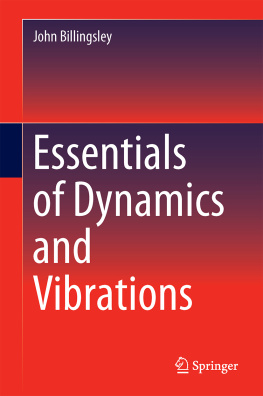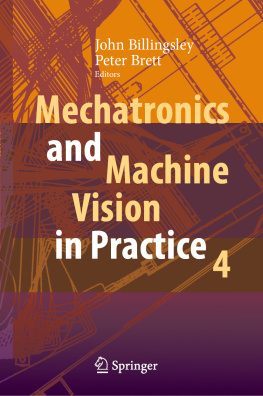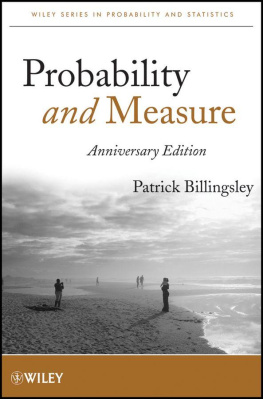1.1 Introduction
This is a very difficult subject, demanding mathematical ability to solve differential equations and to use and manipulate matrices. Before starting, you should visit the mathematical revision material at www.essdyn.com/maths to make sure that you will survive.
You should already be familiar with the dynamics of systems with point masses. Newtons laws have told you how to deal with accelerations and forces, but now you will meet systems with a whole new twist literally.
If you rotate a point mass, it is still a point mass. All that matters is the combination of forces that are trying to accelerate it, together with its present position and velocity.
As soon as you exchange the point for a solid body you have to start thinking in six dimensions, not three. As well as the x , y and z coordinates you have rotations of pitch, roll and yaw to borrow some terms from aviation. As well as forces in three dimensions, you have to consider couples in three more. And instead of the body having a simple mass, it now has a moment of inertia, too. But theres more! That moment of inertia is actually a tensor, represented by a three-by-three matrix.
But as you work through the book, the matrix will become your friend. It will allow you to represent the mathematical relationships in a neat shorthand. It will also allow you to throw together a few lines of software to simulate any awkward system, including orbiting satellites, spinning gyroscopes and vibrating mechanisms.
Matrices also enable us to represent the transformations that describe the motion of the links of a robot.
As well as describing the motion of solid objects in three dimensions, the differential equations you meet can describe vibrations and oscillations that involve multiple modes. Once again you are thrown into the grasp of matrices to separate the individual modes and find their frequencies.
You will also have to recall the fundamentals of solving differential equations, configuring a complementary function to match the initial conditions while finding a particular integral to represent the response to any input function.
1.2 A Little More Detail
Dynamics is the study of how things move, not just point masses but solid objects with rotational momentum. There are fundamental principles that have to be understood, though the detail involves some challenging mathematics. At the centre are Newtons laws, which could be paraphrased as follows:
Unless you push it, it will just keep going at the same velocity.
The harder you push it, the more it will accelerate; acceleration is proportional to the push.
If you push it, it will push you back.
We are so accustomed to Newtons laws that we cannot imagine life without them. They are easily put to the test of our experience but films project a deluge of misinformation. They show star-fighters that zoom away in space just by tilting their wings, or orbits that decay with no air-resistance. But possibly the entertainment movies have less to apologise for than the television documentaries that get it wrong. It will be worth devoting an entire chapter to media howlers.
Gyroscopes are regarded with the same mystique as zombies and vampires. The reputation of a very distinguished professor was tarnished by a belief that they could be used for space propulsion. Perhaps they can, but not in any way that conforms with our reliance on Newtons laws. Though there are dangers in holding any belief too strongly, gyroscopic propulsion can be put into the same basket as perpetual motion.
But gyroscopes lead us unto another aspect of the theory. Newton was intrigued by linear motion, but we must also consider rotation. Just as the second law tells us to take account of linear momentum and forces, so we must additionally consider angular momentum and couples. This is where the lovers of mathematics can really come into their own!
Spinning objects can do remarkable things. A spinning top can stand upright. A coin can roll across the floor without falling over until it slows down, the dynamics of the front wheel of a bicycle will let us ride it no hands. But irregular objects can do even more remarkable things.
If you search on the web for Dancing T-handle you will see some video footage that was taken in an orbiting space station. A T-shaped bar spins helicopter style for a brief while, then it suddenly flips so that the stem is pointing in the opposite direction, then repeatedly it flips back and forth again. How can we wrap our minds around that sort of motion? Well the power of the computer is there to help us.
HTML5, the canvas object and JavaScript combine together to let us animate pictures on the screen of objects that obey any dynamic equations that we care to define. So at www.essdyn.com/sim/t-handle.htm we can see a simulation that explains it all.
While we can rely on simple concepts for many simulations, understanding the T-handle requires us to look deeper into the mathematics by considering the inertia tensor and Eulers equations. But those come much later.
Many of you readers are likely to be followers of a university course, keen to find how to pass an examination. You will want worked examples on which to try out your mathematical gymnastics. The examples in the text should keep you reasonably satisfied, provided you can resist looking at the solutions that follow them before trying to find solutions of your own. But you might miss the whole point of the book.
The mathematical methods are merely a collection of tools in your toolbox. The essence of a knowledge of dynamics is in knowing which of those tools to apply to each new situation that you might meet. It is not a matter of showing how proficient you are at matrix multiplication.
Your course leader is likely to add one or two of the standard titles to your reading list. I will add a list of further reading without showing a preference for any of the titles. However I will give you a reference to the book that inspired me half a century or more ago the fundamentals have not changed in all that time. You can download Synge and Griffiths Principles of Mechanics, published in 1949, from https://archive.org/details/principlesofmech031468mbp at no cost, but I do not claim that it is easy reading! It goes a lot further than these chapters.












